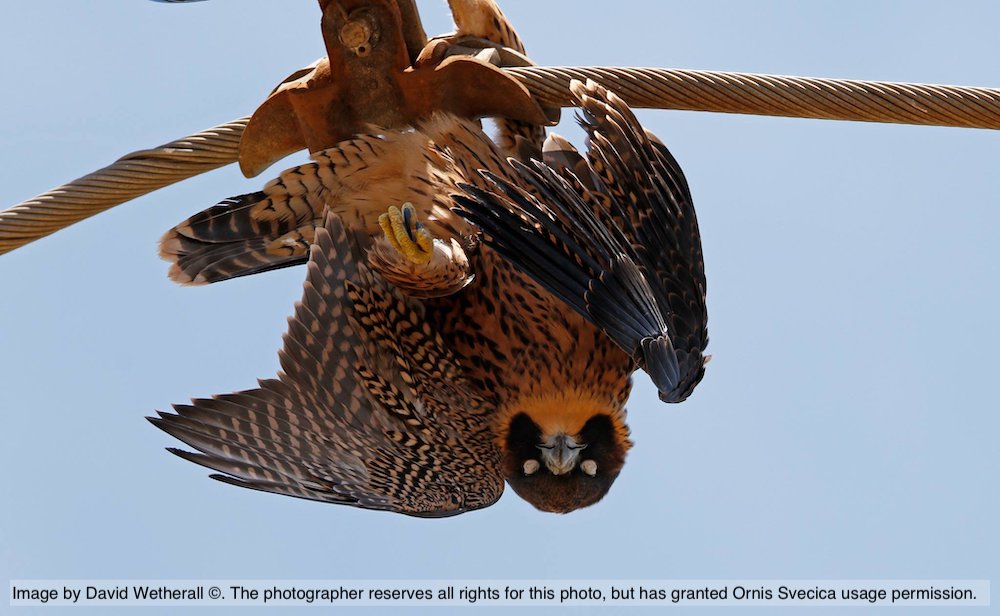Kollisioner med ledningar och elströmsolyckor – en analys baserad på återfynd av ringmärkta fåglar i Sverige 1990–2017
DOI:
https://doi.org/10.34080/os.v29.19731Nyckelord:
kraftledningar, elström, kollision, ringmärkning, ringåterfyndAbstract
Recoveries of birds ringed in Sweden from the period 1990–2017 were used to analyse the occurrence of collisions with power lines and electrocutions. Out of more than 10,000 recoveries of birds found dead with finding circumstances mentioned, 8.6% was associated with power line constructions. The number of species involved was 51 and high proportions were especially evident in some species of owls and raptors. The overall proportion of recoveries caused by collision / electrocution shows a significant decrease over time. A decrease over time in the proportions of electrocution and collision was also evident when analysing finding circumstances in four species where corpses were sent to the Swedish Museum of Natural History. Information about the power line system in Sweden during the period 2007–2016 shows that the length of local power lines has decreased with about 21% during a ten-year period and that underground cables have increased with 28% during the same period. The results show that collisions with power lines have decreased more than electrocutions and this may imply that there are still many places where birds are at risk of being electrocuted.
Nedladdningar
Referenser
Andersen-Harild P & Bloch D. 1973. En foreløbig undersøgelse over fugle dræbt mod elledningar. Dansk Ornitologisk Forenings Tidsskrift 67: 15–23.
Bernardino J, Bevanger K, Barrientos R, Dwyer FF, Marques AT, Martins RC, Shaw JM, Silva JP & Moreira F. 2018. Bird collisions with power lines: State of the art and priority areas for research. Biological Conservation 222: 1–13. https://doi.org/10.1016/j.biocon.2018.02.029 DOI: https://doi.org/10.1016/j.biocon.2018.02.029
Bevanger K. 1994. Bird interactions with utility structures: collision and electrocution, causes and mitigating measures. Ibis 136: 412–425. https://doi.org/10.1111/j.1474-919X.1994.tb01116.x DOI: https://doi.org/10.1111/j.1474-919X.1994.tb01116.x
Bevanger K. 1998. Biological and conservation aspects of bird mortality caused by electricity power lines: a review. Biological Conservation 86:67–76. https://doi.org/10.1016/S0006-3207(97)00176-6 DOI: https://doi.org/10.1016/S0006-3207(97)00176-6
Bevanger K & Overskraug K. 1998. Utility Structures as a mortality factor for Raptors and Owls in Norway. Pp 381–392 in: Chancellor RD, Meyburg BU & Ferrero JJ (eds). Proceedings Holarctic Birds of Prey; ADENEX-WWBP, Badajoz, Extremadura, Spain, 17–22 April 1995.
Bevanger K, Dahl EL, Gjershaug JO, Magnusson N & Refsnæs S. 2014. Challenges and opportunities in preventing bird electrocution in Coastal Norway. Proceedings International Conference on Overhead Lines, 31 March–3 April 2014, Fort Collins, Colorado USA.
Dwyer JF, Harness RE & Donohue K. 2013. Predictive Model of Avian Electrocution Risk on Overhead Power Lines. Conservation Biology 28: 159–168. https://doi.org/10.1111/cobi.12145 DOI: https://doi.org/10.1111/cobi.12145
Ferrer M, de la Riva M & Castroviejo J. 1991. Electrocution of Raptors on Power Lines in Southwestern Spain. Journal of Field Ornithology 62: 181–190.
Fransson T & Stolt B-O. 2000. Fåglar och ledningar – en analys baserad på återfynd av fåglar ringmärkta i Sverige. Naturhistoriska riksmuseet, Stockholm.
Garrido JR & Fernández-Cruz M. 2003. Effects of power lines on a White Stork Ciconia ciconia population in central Spain. Ardea 50: 191–200.
Harness RE & Wilson RW. 2001. Electric-utility structures associated with raptor electrocutions in rural areas. Wildlife Society Bulletin 29: 612–623.
Janss GFE. 2000. Avian mortality from power lines: a morphologic approach of a species-specific mortality. Biological Conservation 95: 353–359. https://doi.org/10.1016/S0006-3207(00)00021-5 DOI: https://doi.org/10.1016/S0006-3207(00)00021-5
Jenkins AR, Smallie JJ & Diamond M. 2010. Avian collisions with power lines: a global review of causes and mitigation with a South African perspective. Bird Conservation International 20: 263–278. https://doi.org/10.1017/S0959270910000122 DOI: https://doi.org/10.1017/S0959270910000122
Lehman RN. 2001. Raptor Electrocution on Power Lines: Current Issues and Outlook. Wildlife Society Bulletin 29: 804–813.
Lehman RN, Kennedy PL & Savidge JA. 2007. The state of the art in raptor electrocution research: A global review. Biological Conservation 136: 159–174. https://doi.org/10.1016/j.biocon.2006.09.015 DOI: https://doi.org/10.1016/j.biocon.2006.09.015
Loss SR, Will T & Marra PP. 2014. Refining Estimates of Bird Collision and Electrocution Mortality at Power lines in the United States. PLOS One 9(7): e101565. https://doi.org/10.1371/journal.pone.0101565 DOI: https://doi.org/10.1371/journal.pone.0101565
Manville II AM. 2005. Bird strikes and electrocutions at power lines, communication towers, and wind turbines: state of the art and state of the science – next steps toward mitigation. Pp 1051–1064 in: Ralph CJ & Rich TD (eds). Bird Conservation Implementation in the Americas: Proceedings of the Third International Partners in Flight Conference, 20–24 March 2002. USDA Forest Service General Technical Report PSW-GTR-191, Pacific Southwest Research Station, Albany, CA. Available at https://www.fs.usda.gov/treesearch/pubs/32105
Rubolini D, Gustin M, Bogliani G & Garavaglia R. 2005. Birds and powerlines in Italy: an assessment. Bird Conservation International 15: 131–145. https://doi.org/10.1017/S0959270905000109 DOI: https://doi.org/10.1017/S0959270905000109
Schaub M. & Pradel R. 2004. Assessing the relative importance of different sources of mortality from recoveries of marked animals. Ecology 85: 930–938. https://doi.org/10.1890/03-0012 DOI: https://doi.org/10.1890/03-0012
Scott RE, Roberts LJ & Cadbury CJ. 1972. Bird deaths from power lines at Dungeness. British Birds 65: 273–286.
Sergio F, Marchesi L, Pedrini P, Ferrer M & Penteriani, V. 2004. Electrocution alters the distribution and density of a top predator, the eagle owl Bubo bubo. Journal of Applied Ecology 41: 836–845. https://doi.org/10.1111/j.0021-8901.2004.00946.x DOI: https://doi.org/10.1111/j.0021-8901.2004.00946.x
Shaw JM, Reid TA, Schutgens M, Jenkins AR & Ryan PG. 2018. High power line collision mortality of threatened bustards at a regional scale in the Karoo, South Africa. Ibis 160: 431–446. https://doi.org/10.1111/ibi.12553 DOI: https://doi.org/10.1111/ibi.12553
Statens Planverk. 1985. Kraftledningar i fysisk planering. Rapport 46 (reviderad 1985).
Stolt B-O & Fransson T. 1987. Vilka fågelarter drabbas värst av el- och ledningsolyckor? Calidris 16: 182–189.
Stolt B-O, Fransson T, Åkesson S. & Sällström B. 1986. Luftledningar och fågeldöd. Naturhistoriska riksmuseet, Stockholm.
Tintó A, Real J & Mañosa S. 2010. Predicting and Correcting Electrocution of Birds in the Mediterranean Areas. Journal of Wildlife Management 74: 1852–1862. https://doi.org/10.2193/2009-521 DOI: https://doi.org/10.2193/2009-521

Downloads
Publicerad
Referera så här
Nummer
Sektion
Licens
Copyright (c) 2019 Thord Fransson, Lina Jansson, Tuomo Kolehmainen, Thomas Wenninger

Det här verket är licensierat under en Creative Commons Erkännande 4.0 Internationell-licens.
Författaren/författarna innehar copyright för varje enskilt bidrag, men samtliga bidrag är publicerade under en Creative Commons-licens, så att vem som helst kan dela och återanvända bidraget förutsatt att copyright-innehavaren erkänns.







